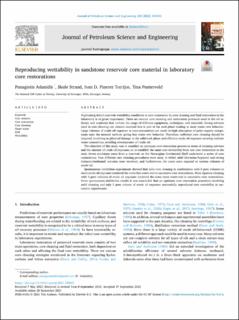| dc.contributor.author | Aslanidis, PANAGIOTIS | |
| dc.contributor.author | Strand, Skule | |
| dc.contributor.author | Piñerez Torrijos, Iván Darío | |
| dc.contributor.author | Puntervold, Tina | |
| dc.date.accessioned | 2022-01-12T12:28:46Z | |
| dc.date.available | 2022-01-12T12:28:46Z | |
| dc.date.created | 2021-09-23T00:48:21Z | |
| dc.date.issued | 2021-09 | |
| dc.identifier.citation | Panagiotis, A., Strand, S., Piñerez Torrijos, I.D., Puntervold, T. (2021) Reproducing wettability in sandstone reservoir core material in laboratory core restorations. Journal of Petroleum Science and Engineering, 208(C), 109531 | en_US |
| dc.identifier.issn | 0920-4105 | |
| dc.identifier.uri | https://hdl.handle.net/11250/2837121 | |
| dc.description.abstract | Replicating initial reservoir wettability conditions in core restoration by core cleaning and fluid restoration in the laboratory is of great importance. There are several core cleaning and restoration protocols used in the oil industry and academia that include the usage of different equipment, techniques, and materials. Strong solvents used in core cleaning can remove material that is part of the rock phase leading to more water–wet behavior. Large volumes of crude oil exposure in core restorations can result in high adsorption of polar organic components onto the mineral surfaces giving less water–wet behavior. Therefore, sufficient core cleaning should be targeted, involving no physical damage to the solid rock phase and effective crude oil exposure securing realistic water saturations, avoiding overexposure of crude oil.
The objective of this study was to establish an optimum core restoration process in terms of cleaning solvents and the amount of crude oil exposure, to re-establish the same core wettability from one core restoration to the next. Seven sandstone cores from a reservoir on the Norwegian Continental Shelf underwent a series of core restorations. Two different core cleaning procedures were used, in which mild (kerosene/heptane) and strong (toluene/methanol) solvents were involved, and furthermore, the cores were exposed to various volumes of crude oil.
Spontaneous imbibition experiments showed that mild core cleaning in combination with 5 pore volumes or more crude oil exposure rendered the cores less water-wet in successive core restorations. More rigorous cleaning with 5 pore volumes of crude oil exposure rendered the cores more water-wet in successive core restorations. From spontaneous imbibition results it was concluded that an optimum core restoration procedure involving mild cleaning and only 1 pore volume of crude oil exposure successfully reproduced core wettability in successive experiments. | en_US |
| dc.language.iso | eng | en_US |
| dc.publisher | Elsevier Ltd. | en_US |
| dc.rights | Navngivelse 4.0 Internasjonal | * |
| dc.rights.uri | http://creativecommons.org/licenses/by/4.0/deed.no | * |
| dc.subject | petroleumsteknologi | en_US |
| dc.subject | EOR | en_US |
| dc.subject | wettability | en_US |
| dc.title | Reproducing wettability in sandstone reservoir core material in laboratory core restorations | en_US |
| dc.type | Peer reviewed | en_US |
| dc.type | Journal article | en_US |
| dc.description.version | publishedVersion | en_US |
| dc.rights.holder | © 2021 The Authors | en_US |
| dc.subject.nsi | VDP::Teknologi: 500::Berg‑ og petroleumsfag: 510::Petroleumsteknologi: 512 | en_US |
| dc.source.pagenumber | 109531 | en_US |
| dc.source.volume | 208 C | en_US |
| dc.source.journal | Journal of Petroleum Science and Engineering | en_US |
| dc.identifier.doi | 10.1016/j.petrol.2021.109531 | |
| dc.identifier.cristin | 1937384 | |
| cristin.ispublished | true | |
| cristin.fulltext | original | |
| cristin.qualitycode | 2 | |

